If you're in the marketing automation space, you know that HubSpot and Marketo are frontrunners when it comes to software that will make your job easier.
Both offer all the core features required of a marketing automation platform, but they also go beyond what standard marketing automation tools give you. That's good, yes, but it also means it's a lot to wrap your head around.
Here, I'll walk you through HubSpot's and Marketo's offerings and then show you how, in the end, they're built for different kinds of teams. But first, let's meet the apps.
What is Marketo?
Marketo was founded in 2006 with one clear goal: to help CMOs and their teams demonstrate the ROI of their marketing efforts. Initially, it started as a lead management startup but has, over the years, snowballed into a marketing automation powerhouse with features like:
Lead scoring and nurturing
Marketing automation
Account-based marketing
Smart campaigns (workflow automation)
Email marketing
Digital advertising
Reporting
… just to mention a few. In 2018, creative software giant Adobe acquired Marketo for a staggering $4.7 billion and renamed the product Marketo Engage.
What is HubSpot Marketing Hub?
HubSpot is an all-in-one tool, and Marketing Hub is the primary marketing automation system within the HubSpot ecosystem. It's almost impossible to use HubSpot without digging into tools from its other hubs (Sales, Service Hub, Operations, CMS, and Commerce), but for this comparison, I'm focusing on Marketing Hub—it's the product that aligns most closely with Marketo.
HubSpot vs. Marketo at a glance
I use HubSpot to run my business, and to write this article, I spent more time digging deep into all of the Marketing Hub features. Unfortunately, I couldn't test Marketo firsthand—it's tough to get a working trial. Instead, I gathered information from Marketo University, as well as third-party demos and online reviews.
Here's a quick comparison table highlighting the main differences between HubSpot and Marketo. Keep reading for more details on how they differ.
| HubSpot | Marketo |
|---|---|---|
Features | ⭐⭐⭐⭐ Feature rich when compared to almost every other platform, but when compared to Marketo, it misses in a few areas. | ⭐⭐⭐⭐⭐ Everything that HubSpot has, plus more advanced options for campaigns, analytics, and reporting. |
Ease of use | ⭐⭐⭐⭐⭐ Simplified platform is suitable for less experienced marketers. There's a slight learning curve as you require more features or your needs grow, but it's generally easy to figure out with hints and pop-ups to help. | ⭐⭐⭐ Marketo has a steep learning curve, especially if you're new to marketing automation. You'll require training from Marketo University to use the tool properly. |
Contact management | ⭐⭐⭐⭐⭐ Has a built-in CRM for contact management and allows native integration with hundreds of other CRMs. | ⭐⭐⭐ No built-in CRM and only connects to Salesforce and Microsoft Dynamics natively. |
Automation and workflow | ⭐⭐⭐⭐ Comes with a visual automation builder for building workflows. | ⭐⭐⭐⭐ No visual builder but allows you to build more complex campaigns with deeper customization and optimization options. |
Customer support | ⭐⭐⭐⭐⭐ Very responsive support system. Once you open a chat in the tool, you'll be assigned a competent rep to answer your question in minutes. Phone calls are also available for users on higher-tier plans. | ⭐⭐⭐⭐ Email-only support that's slow to respond. You're better off finding answers in discussion forums and the Marketing Nation community. |
Integration | ⭐⭐⭐⭐⭐ Integrates with lots of third-party tools, including Zapier. | ⭐⭐⭐⭐⭐ Integrates with lots of third-party tools, including Zapier. |
Free trial | ⭐⭐⭐⭐⭐ HubSpot offers a free CRM and other tools to automate basic marketing needs. There's also a 14-day free trial on higher-tier plans. | ⭐ No free tool and no free trial, so it's near impossible to test run the platform before committing. |
Pricing | ⭐⭐⭐⭐ Entry-level pricing for small businesses but gets expensive as you scale. | ⭐⭐⭐ Very expensive from the outset. There's no pricing displayed on the website, so you need to contact sales for a quote. |
HubSpot is easier to use, but Marketo offers more depth
One of the first things that separates Marketo and HubSpot is the level of skill required to use each platform. While HubSpot presents a simpler interface perfect for less experienced users, Marketo caters more to advanced marketing specialists—and it starts with their onboarding processes.
Once you sign up with HubSpot, you'll find a step-by-step walkthrough for setting up your account with contacts, user roles, emails, forms, and tracking. Since the platform comes with its own CRM, no integration process is needed. This means you can bring in your contacts and leads and get started almost immediately. The entire setup is straightforward. There are lots of features, but you can still get it going independently with support from interactive demo videos and help docs if you get stuck.
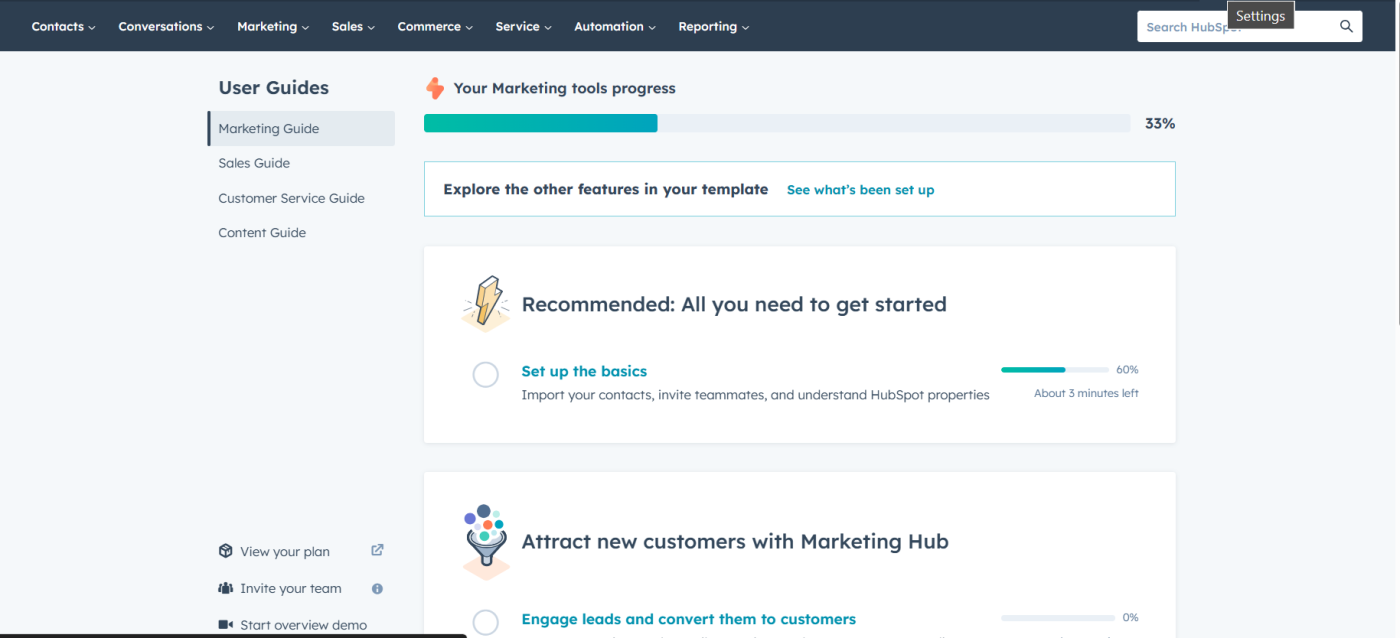
Getting started with Marketo is quite different. It has a longer onboarding process that requires advanced experience and help from your IT team. There's no built-in CRM, so you'll need to integrate your CRM platform using Marketo's connection or API. Even in the Adobe Experience League, Marketo recommends having HTML experience and asking your IT team for assistance in completing the setup steps.
After the setup, HubSpot focuses on simplicity with a modern interface that's easy to navigate and master. All the Hubs are neatly organized at the top navigation bar, with dropdown menus leading to specific tools. It's a lot if you've never used marketing automation before, but a little tinkering and you'll be just fine.
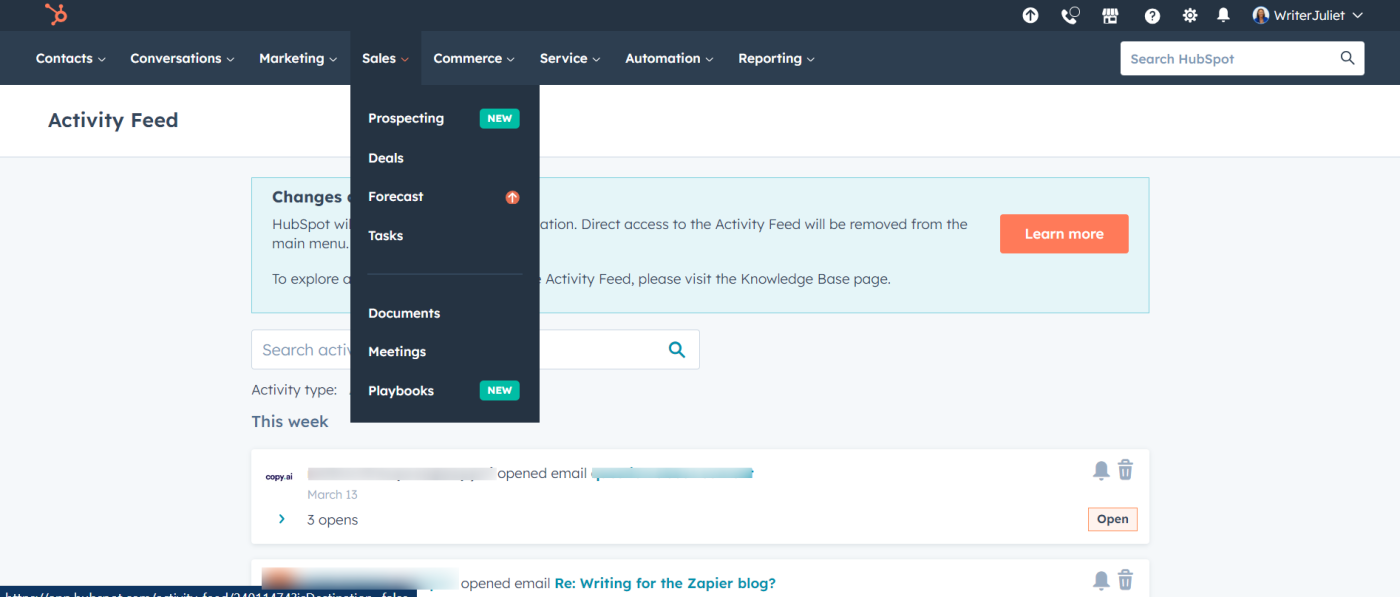
The platform also uses a visual workflow builder that allows you to visualize and build powerful automated marketing campaigns without any previous experience.
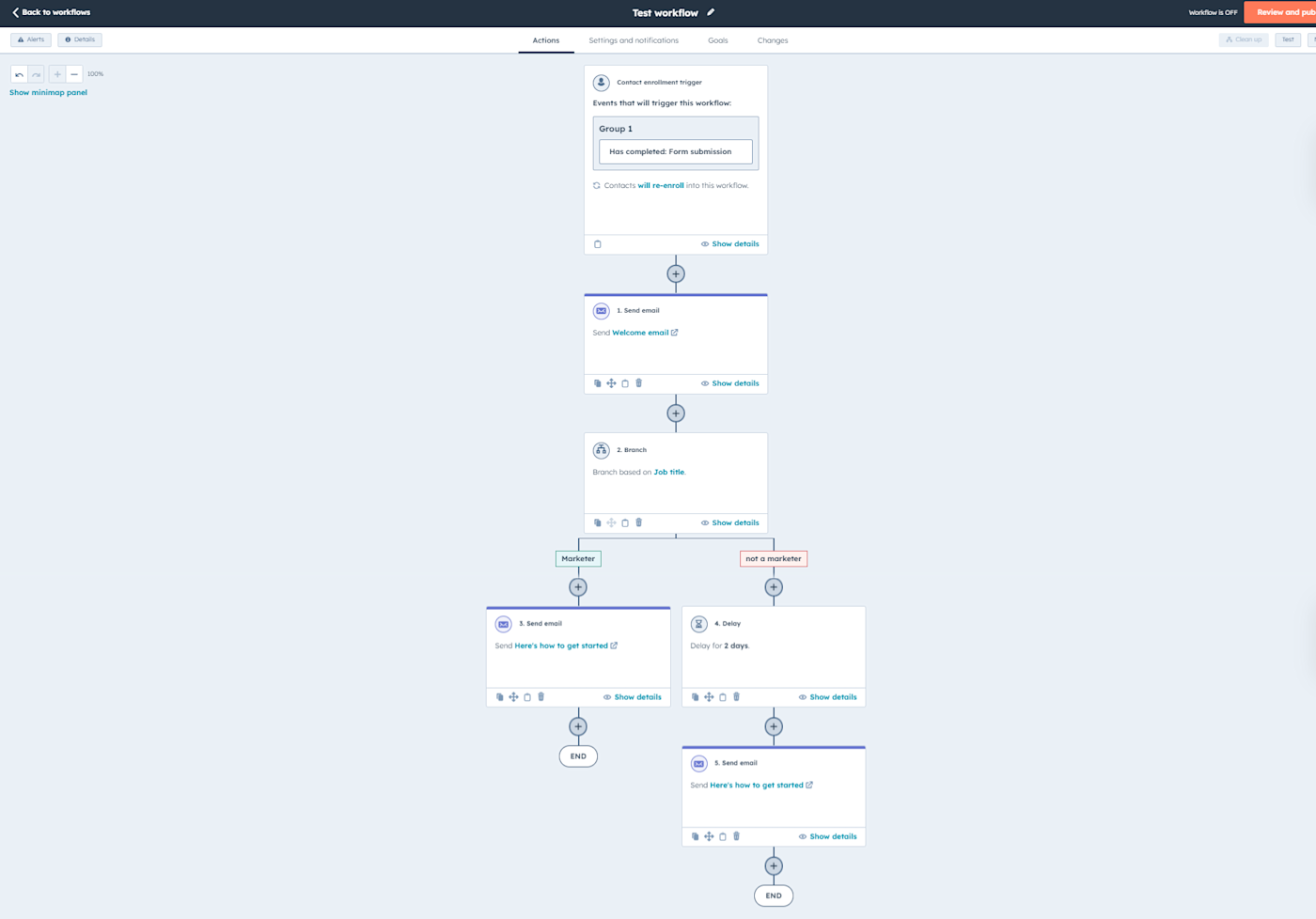
Conversely, Marketo presents a more mature interface that might take a while to get used to (as evidenced by this discussion on Reddit). It uses a modular approach that splits the platform's capabilities into sections, like Marketing Activities, Design Studio, Database, Analytics, and Admin. Each section is further broken down into folders that can be overwhelming for newbies.
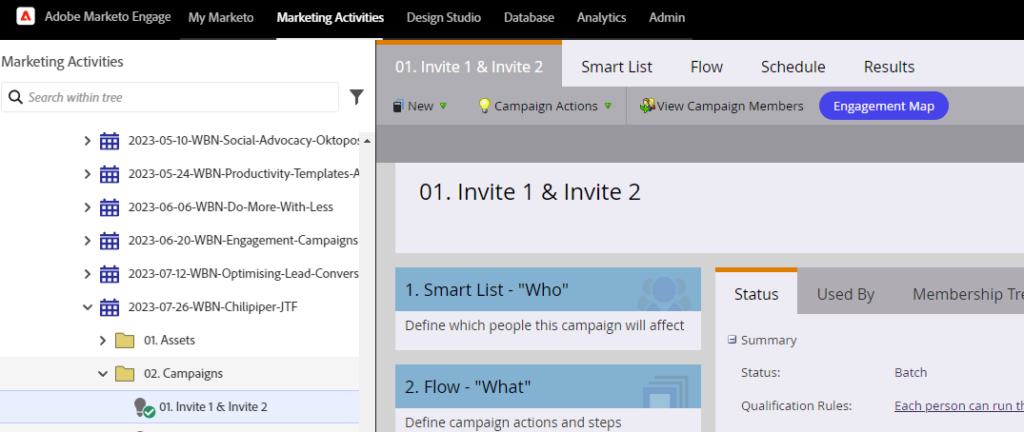
Marketo doesn't provide a visual workflow builder when setting up marketing campaigns. But its automation tool—Smart Campaigns—offers a deeper approach to marketing automation with more customization and optimization capabilities than HubSpot. For instance, while both HubSpot and Marketo offer branching logic within campaigns, Marketo allows you to get granular by setting highly specific conditions beyond basic form submissions, email, and list membership. You can, for example, include data points like website behavior and purchase history, and then tailor the campaign accordingly. And when it comes to lead nurturing and scoring, Marketo offers more advanced capabilities, with dynamic content and multi-channel lead scoring based on several engagement metrics.
So while the platform may be overwhelming for a beginner, experienced marketers seem to prefer it for running and managing complex campaigns. But if you're new to automated marketing and looking to implement Marketo, you should attend training through Marketo University to get up to speed faster.
HubSpot has a built-in CRM, while Marketo is for teams already using Salesforce or Microsoft Dynamics
HubSpot has a built-in customer relationship management (CRM) system that connects natively with every product the platform offers. The CRM allows you to store and manage customer data and monitor their activities across sales, marketing, customer service, and operations. (Even if you're not using those other Hubs, it stores your marketing contacts.)
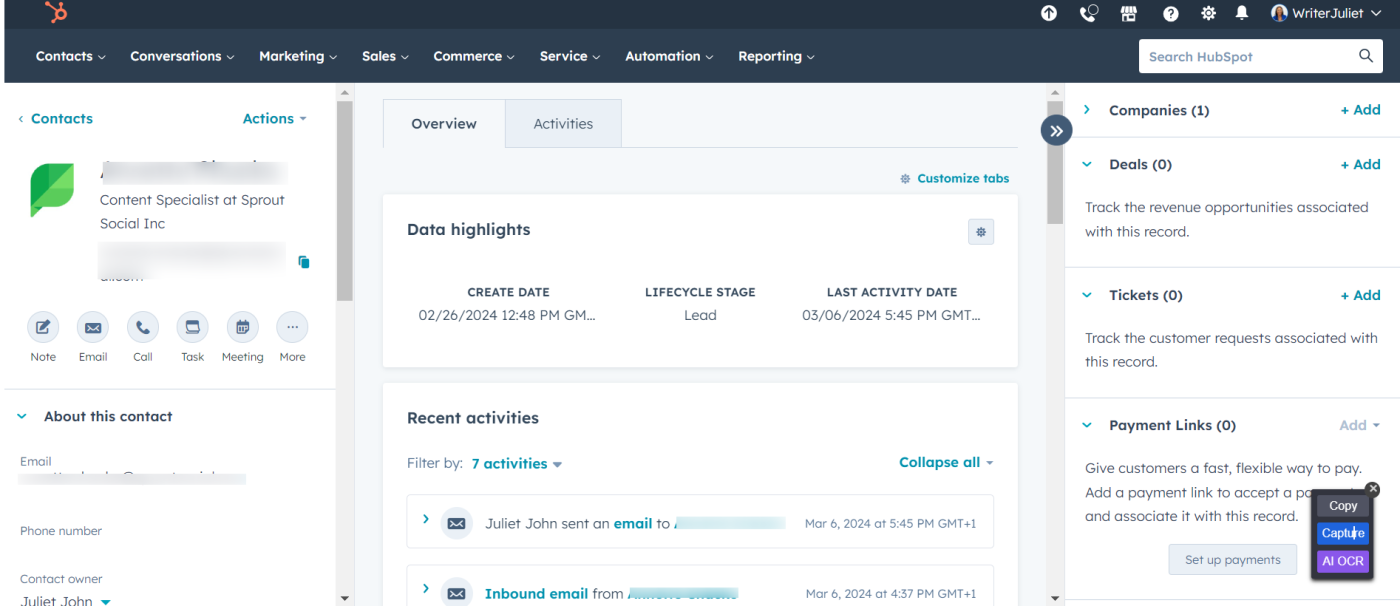
This seamless flow of data improves sales and marketing collaboration and gives you clear insights into where each customer stands with your business throughout their journey.
HubSpot CRM is remarkably easy to adopt (not to mention, it's free to use without any restriction to its core features). And if you prefer to use another CRM, HubSpot offers native integrations with 100+ third-party CRMs.
Marketo doesn't have a built-in CRM. Instead, it provides powerful integrations (CRM sync) with two top CRM providers: Salesforce and Microsoft Dynamics 365. Marketo can send leads who are close to the buying stage to your CRM, so your sales team can work on them, and data from sales activities are seamlessly sent from your CRM back to Marketo to power your campaigns and analytics. The data sync between Marketo and CRM systems is impressive, allowing them to talk to each other while giving you a complete view of your leads and their behavior in both systems.
But because Marketo only offers this native integration for Salesforce and Microsoft, it's less seamless for anyone using a different CRM. It's possible, using custom fields and a tool like Zapier, but it'll require a lot more setup.
Marketo provides better analytics and reporting (with add-ons)
Both Marketo and HubSpot provide comprehensive reports, dashboards, and analytics tools for different needs. In either app, you can gain insight into the impact of marketing and sales activities, customer behavior, and revenue generation.
But Marketo goes a bit further to provide more custom reporting options, such as advanced business intelligence and advanced journey analytics. These reports provide an in-depth analysis of companies, programs, leads, and other critical data points.
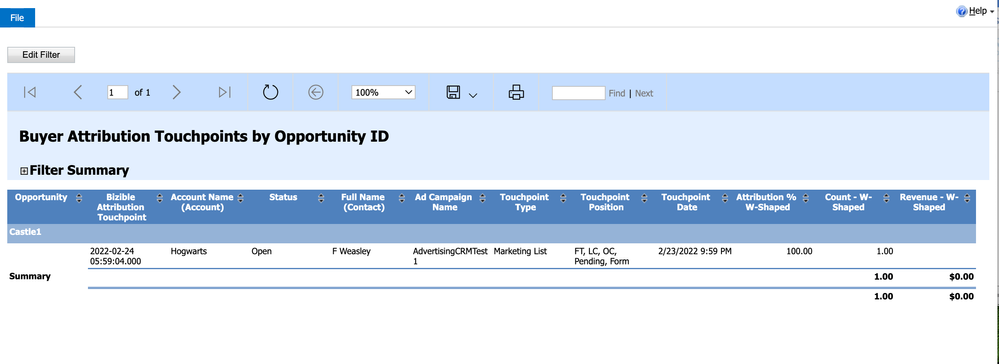
Just keep in mind that some of these reports come at an additional fee and require integration with an attribution tool like Marketo Measure (formerly Bizible).
HubSpot is better for small businesses
HubSpot's all-in-one approach and focus on simplicity make it more suitable for small businesses looking to run automated marketing without using too many resources. It offers lots of free marketing tools and low entry pricing (from $15/month), allowing you to start small and scale gradually. Running your business with HubSpot also means there's no need for significant changes to your marketing stack as your business grows.
On the other hand, Marketo is a better fit for larger companies looking for a robust marketing automation tool to handle complex marketing operations—and ideally companies that already use Salesforce or Microsoft Dynamics. It's more expensive, has a steeper learning curve, and requires more technical expertise to set up and manage, but it does have extra features for managing complex marketing automation tasks.
Both tools connect with Zapier
Both HubSpot and Marketo allow you to extend their capabilities by connecting them with other tools in your tech stack (though HubSpot has more native integrations). And they both integrate with Zapier, so you can connect them to thousands of other tools that they don't support natively.
By connecting HubSpot and Marketo to Zapier, you can do things like create new leads from form submissions, notify your team about activity, or capture leads from events. Learn more about how to automate Marketo and how to automate HubSpot, or get started with one of these pre-built templates.
Add new HubSpot contacts to Google Ads customer lists
Add contacts to a Google Ads customer list for new leads on Marketo
Marketo vs. HubSpot: Which should you choose?
With HubSpot, you'll get a simple-to-use, all-in-one platform for everything: sales, marketing, service, operations, commerce, and CMS. With everything in one place, you can easily map each customer's journey and get in-depth visibility of their actions across every aspect of your business. You may not have access to extensive customization and personalization options, but that may not be a problem, depending on the size of your business—HubSpot has plenty for a small or medium business.
Marketo, on the other hand, is purely marketing automation software. To get the level of visibility HubSpot provides in Marketo, you may need to invest in multiple platforms and integrate them. While it's not a bad way to do things, it may be less convenient depending on your business size and skill level as a marketer. But Marketo's advanced marketing and automation capabilities remain unmatched, making it a strong choice for large companies with complex marketing needs, a big budget, and the technical skills to match.
Related reading:





